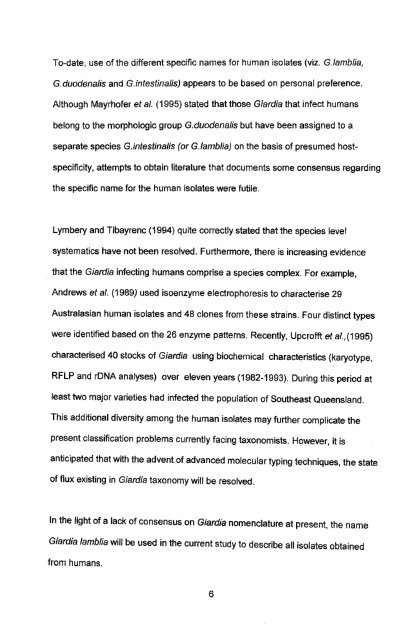in vitro culture and isoenzyme analysis of giardia lamblia
in vitro culture and isoenzyme analysis of giardia lamblia
in vitro culture and isoenzyme analysis of giardia lamblia
You also want an ePaper? Increase the reach of your titles
YUMPU automatically turns print PDFs into web optimized ePapers that Google loves.
To-date, use <strong>of</strong> the different specific names for human isolates (viz. G.Jamblia,<br />
G.duodena/is <strong>and</strong> G.<strong>in</strong>test<strong>in</strong>alis) appears to be based on personal preference.<br />
Although Mayrh<strong>of</strong>er et al. (1995) stated that those Giardia that <strong>in</strong>fect humans<br />
belong to the morphologic group G.duodenalis but have been assigned to a<br />
separate species G.<strong>in</strong>test<strong>in</strong>alis (or G./amb/ia) on the basis <strong>of</strong> presumed hostspecificity,<br />
attempts to obta<strong>in</strong> literature that documents some consensus regard<strong>in</strong>g<br />
the specific name for the human isolates were futile.<br />
Lymbery <strong>and</strong> Tibayrenc (1994) quite correctly stated that the species level<br />
systematics have not been resolved. Furthermore, there is <strong>in</strong>creas<strong>in</strong>g evidence<br />
that the Giardia <strong>in</strong>fect<strong>in</strong>g humans comprise a species complex. For example,<br />
Andrews et al. (1989) used <strong>isoenzyme</strong> electrophoresis to characterise 29<br />
Australasian human isolates <strong>and</strong> 48 clones from these stra<strong>in</strong>s. Four dist<strong>in</strong>ct types<br />
were identified based on the 26 enzyme patterns. Recently, Upcr<strong>of</strong>ft et a/.,(1995)<br />
characterised 40 stocks <strong>of</strong> Giardia us<strong>in</strong>g biochemical characteristics (karyotype,<br />
RFLP <strong>and</strong> rDNA analyses) over eleven years (1982-1993). Dur<strong>in</strong>g this period at<br />
least two major varieties had <strong>in</strong>fected the population <strong>of</strong> Southeast Queensl<strong>and</strong>.<br />
This additional diversity among the human isolates may further complicate the<br />
present classification problems currently faC<strong>in</strong>g taxonomists. However, it is<br />
anticipated that with the advent <strong>of</strong> advanced molecular typ<strong>in</strong>g techniques, the state<br />
<strong>of</strong> flux exist<strong>in</strong>g <strong>in</strong> Giardia taxonomy will be resolved.<br />
In the light <strong>of</strong> a lack <strong>of</strong> consensus on Giardia nomenclature at present, the name<br />
Giardia lamb/ia will be used <strong>in</strong> the current study to describe all isolates obta<strong>in</strong>ed<br />
from humans.<br />
6
















